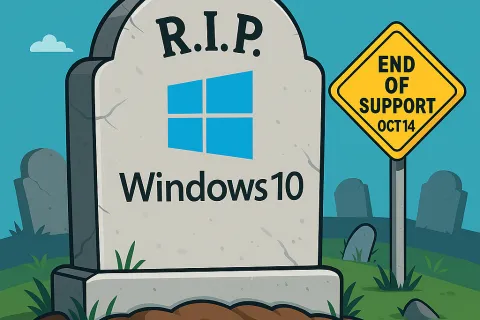For any organization, planning an effective IT budget is as necessary as it is challenging. With the upcoming end-of-life for Windows 10 and other evolving technology needs, it’s important to have a clear strategy to allocate resources wisely. This guide will walk through key elements of IT budgeting, helping you align your budget with your business goals and build flexibility for unexpected changes. Read (or watch) this informative session from CONNECT 2024 – ComTech’s annual live event where Ethan Farlow and a panel of ComTech clients talk about the essentials of your IT budget for 2025.
IT Budgeting: Finding the Right Balance
When approaching an IT budget, many people see IT as just another cost. While it’s essential to be mindful of expenses, IT should be viewed as both an investment and a cost. Effective technology investments may not yield immediate profits, but they can deliver long-term benefits in efficiency, productivity, and risk reduction.
Consider this balance when working with executives or stakeholders, who might naturally lean toward minimizing costs. For example, investing in cybersecurity could seem costly upfront, but it helps prevent expensive disruptions. Avoiding incidents can justify the investment, even if the ROI isn’t instantly visible.
Aligning IT Spending with Business Goals
Before creating a budget, assess your company’s overall goals. Is rapid expansion on the horizon? Are you opening new offices, onboarding more clients, or scaling teams? Or is growth steady and manageable? Fast-growing companies may need to allocate more resources to ensure IT infrastructure and support keep pace, while a slower growth rate might allow for a more conservative budget.
Budget alignment with business goals ensures your technology strategy supports your company’s path, adapting resources and priorities as needed.
Identifying One-Time vs. Recurring Costs
IT budgets generally include both one-time and recurring expenses:
One-Time Costs: These are typically project-based expenses, such as hardware replacements, major software upgrades, or cabling projects. For instance, with Windows 10 reaching end-of-life in 2025, replacing any remaining Windows 10 machines is likely to be a one-time cost for many companies.
Recurring Costs: Subscriptions for software like Adobe and Microsoft, ongoing IT support, and cybersecurity services all fall under recurring costs. These expenses are essential to keeping your systems running efficiently and securely over time.
Understanding these two categories can help you budget more accurately and avoid unexpected expenses.
Build in a Buffer for Unanticipated Needs
Adding a 5-10% buffer to your IT budget is wise, especially for emergencies or unexpected growth. A buffer can help cover costs if critical hardware fails, a cybersecurity incident occurs, or if you experience rapid growth that requires immediate technology upgrades. By planning for the unexpected, you can avoid disruptions and ensure continuity.
A Sample IT Budget: Structuring Your 2025 Costs
For example, let’s consider a 25-person company. A basic 2025 budget might look something like this:
- One Time
- 10 Workstations – $10,000
- Replace Wireless Network – $4,000
- Recurring IT Costs
- 25 Workstations IT/Cybersecurity – $40,000
- 25 Email Licenses – $3,750
- 5 Adobe Licenses – $1,800
- 25 Phones – $6,000
- Spectrum Internet – $2,400
- Buffer
- 5% of Total Budget – $4,050
Total 2025 Budget – $72,000
This basic plan, plus a 5% buffer, might amount to $72,000 for the year. For ComTech clients, planning is even simpler. We provide monthly hardware lifecycle reports and other insights to help spread out upgrades across quarters, making financial planning more manageable. Instead of purchasing machines every four years, consider Hardware as a Service (HaaS) for a more predictable, easy to manage solution for your business.
Factoring in Time Savings as Part of IT Investment
Beyond costs, IT budgets should consider potential time savings. Investing in proactive upgrades and preventative maintenance can significantly reduce downtime and improve productivity. For example, some companies opt to replace workstations every three years to minimize tech-related interruptions, while others may choose a more flexible approach based on specific needs.
Taking time savings into account helps you understand the true value of IT investments. Small increases in spending can often lead to large gains in productivity and efficiency.
Key IT Considerations for 2025
Windows 10 End of Life Support: With Windows 10 support ending in 2025, it’s essential to plan for upgrading machines. Delaying until the last minute can create budget strain and operational challenges.
Cybersecurity Training: Even with robust security tools, untrained employees can be a weak point in any security strategy. Including regular cybersecurity training in your budget helps ensure that your team remains vigilant against cyber threats. For a no-cost solution, consider our CyberHero Academy. Learn more at https://comtechnc.com/cyberhero-academy
Recurring License Reviews: Set a schedule to review your recurring licenses annually. This step can identify and eliminate unused or outdated licenses, preventing unnecessary costs.
Creating an effective IT budget for 2025 may not be the most exciting task, but it’s a fundamental step in securing and supporting your business’s growth. With a proactive approach, careful planning, and support from a trusted IT provider, your business can transition smoothly into the future. ComTech offers ongoing support to help clients optimize their IT budgets. Our client portal provides easy access to data and tools for planning and tracking expenses, and our team is available to discuss strategies for maximizing IT efficiency while staying within budget.
For more information about budgeting for 2025, feel free to reach out –https://comtechnc.com/contact-us.







